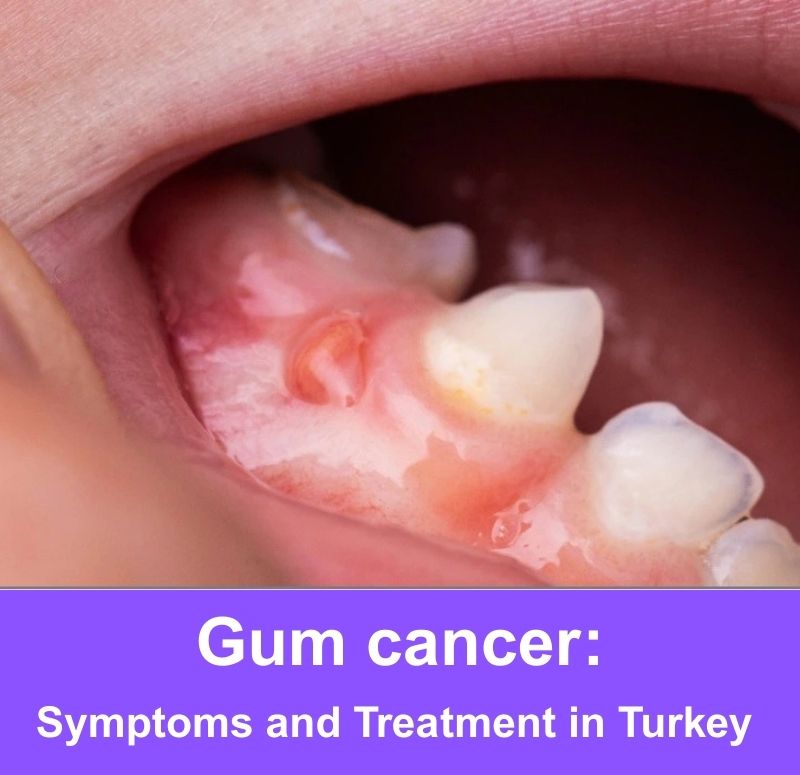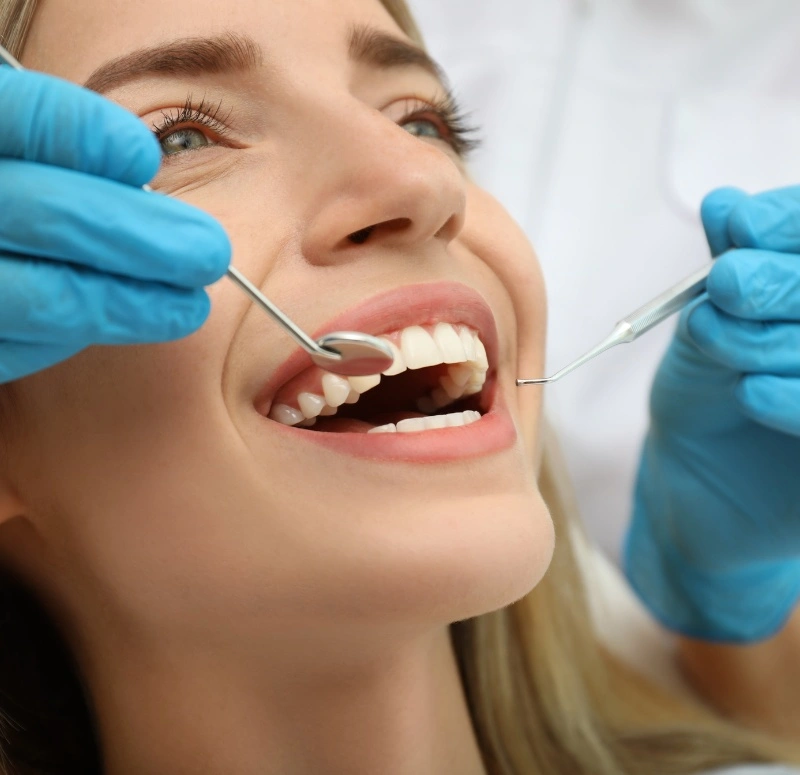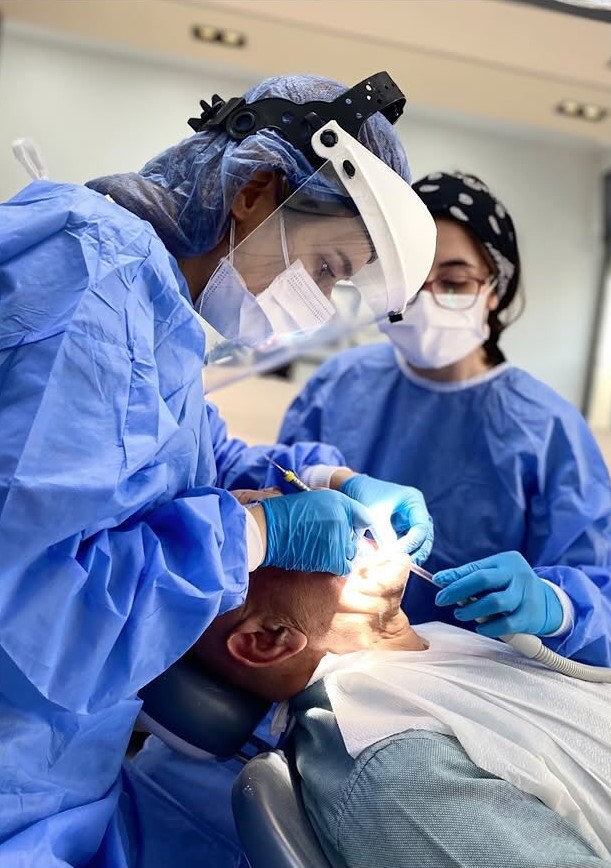Gum cancer: Symptoms and Treatment in Turkey

Gum cancer - Mouth cancer (Oral cancer)
Gum cancer is characterised by non-healing wounds, swelling, and uncontrolled growth, as well as white and red spots on the gums. Frequent bleeding while brushing your teeth; bleeding that lasts for weeks; and discolouration of the gums can be signs of gum cancer. If you are experiencing such symptoms, you should consult a dentist.
What is gum cancer?
Gum cancer is a type of cancer that occurs when malignant tumors develop in the gums. It is not as common as other oral cancers but should be taken seriously. It usually appears as a sore that won’t heal— a swelling or a white or red spot on the gums. It can bleed and grow over time. You can compare the gums to the foundation of a building. A cancer in the gums can seriously affect your whole mouth, including your teeth.
As with all types of cancer, early diagnosis is crucial for gum cancer. If you notice a sore on the gums that does not heal, abnormal discolouration or persistent bleeding, you should be examined by a dentist immediately.
What is a gum tumour?
A gum tumor is an abnormal growth of tissue in the gums. It can be completely harmless (benign) or malignant (gum cancer). In other words, malignant gum tumours are also called gum cancer. If an early diagnosis is not made and precautions are not taken, they spread to other tissues. It is like an insignificant crack on the windscreen of your car that grows over time and covers your entire windscreen.
In some of our patients, we notice a small swelling in the gums or a wound that does not heal. They may not pay much attention at first. But if such changes do not go away in a few weeks, it is essential to see a dentist. Early diagnosis makes a big difference.
What is the relationship between oral cancer and gum cancer?
Oral cancer is a type of cancer that can develop in any part of the mouth, such as the lips, tongue, cheeks, palate, floor of the mouth and gums. Gum cancer is a type of oral cancer and occurs when cells in the gum tissue grow uncontrollably. Initially, it can often be mistaken for gingivitis or another gum problem. It usually spreads slowly and accounts for about 6% of all oral cancers.
The majority of oral cancers (more than 90%) are squamous cell carcinoma, which starts in the thin, flat cells lining the lining of the mouth and throat. Other common oral cancers include cancer of the tongue, lips, floor of the mouth and palate.
What are the symptoms of gum cancer?
Symptoms of gum cancer differ depending on whether it is early or late stage. Early diagnosis is critical for the success of treatment. If you experience one or more of the following symptoms, you should consult your dentist.
Early-stage symptoms
- You may experience sores or ulcers on your gums that do not heal.
- Discoloration of the oral cavity is a common symptom of oral cancer. This discoloration usually appears as white or red spots or plaques on the gums or surrounding areas (American Cancer Society).
- White, red, or dark spots inside the mouth.
- The patient is experiencing bleeding or cracking.
- The patient is experiencing a lump or a feeling of swelling in the mouth.
- The patient is experiencing pain in mouth or jaw.
- The patient is experiencing difficulty chewing or swallowing.
- The patient is experiencing voice changes or difficulty speaking.
Late symptoms
- Loose teeth or tooth loss.
- Restricted or “locked” jaw movements.
- Swollen lymph nodes in the neck. Gum cancer can spread to nearby lymph nodes. The closest is the cervical lymph node, which is located on the sides, front and back of the neck. This can cause lymph node swelling, which can be detected by palpating the front of the neck. Not everyone with oral cancer will present with lymph node metastases, but about 25% of those who do not initially will develop the condition within two years.
- Like oral cancer, gum cancer may not be very painful at first. As the tumor progresses, you may experience pain or a burning sensation in your mouth. The pain is usually permanent and can get worse over time. It can also spread to the ear area.
- Decrease in your weight.
Who is at risk of gum cancer?
Knowing the factors that cause gum cancer is very important for both prevention and early diagnosis. We can list the most common as follows.
- Tobacco use: Smoking cigarettes, cigars, pipes or tobacco significantly increases the risk of gum cancer.
- Alcohol consumption: Drinking alcohol continuously and in large quantities, especially when combined with smoking, greatly increases the risk.
- HPV infection: The human papillomavirus (HPV) is the most important infection that can cause cancer in the mouth. Some types are particularly associated with oral cancer.
- Malnutrition: If the diet is inadequate, the vitamins and minerals that protect against cancer cannot be taken in adequately. This situation facilitates cancer formation.
- Age: Gum cancer is more common in people over 40. Since cells are more likely to mutate over time, the risk increases with age.
- Gender: Gum cancer is more common in men than in women. This is due to hormonal differences and generally higher rates of smoking and alcohol use.
- Overexposure to the sun: Prolonged exposure to sunlight increases the risk of lip cancer in particular. Using lip balm when going out is as important for oral health as it is for skin health.
- Weakened immune system: When the immune system is weakened, the body has difficulty fighting cancerous cells. People with HIV/AIDS or those taking immunosuppressive drugs are at higher risk.
- Previous cancer diagnosis: People who have had cancer in the head and neck area are at higher risk of gum cancer.
- Genetic predisposition: If there is a family history of oral cancer, the risk is slightly increased. Some people may be genetically more vulnerable.
- Exposure to chemicals: Prolonged contact with certain chemicals, such as asbestos and sulphuric acid, can increase the risk of oral cancer.
- Chronic oral irritations: Constantly irritating dentures, sharp tooth surfaces or fillings can weaken oral tissue over time and initiate changes in cells.
- Poor oral hygiene: Not taking care of your teeth and gums can lead to gum disease and, in the long run, cancer. Neglecting oral health is like handing over your garden to weeds, after a while everything gets out of control!
How to diagnose gum cancer?
In the diagnosis of gum cancer, the formation of a white or red mass in the gum that protrudes outwards is an important criterion. This mass is sometimes seen to bleed. Physical examination, patient complaints and some tests are evaluated in the diagnosis of gum cancer. The diagnosis process is based on the following:
- Examination by the dentist: The dentist examines the inside of the mouth in detail and checks suspicious areas.
- Biopsy: A small tissue sample is taken and examined under a microscope.
- X-ray: Shows whether there is bone loss or tumors.
- CT scan: Shows detailed changes in deep tissues.
- MRI scan: Determines whether the cancer has spread to soft tissues.
- Sores that do not heal: Sores in the mouth that do not heal for weeks.
- Red or white spots: Discoloration of the gums that does not go away.
- Swelling: Hardness or thickening that appears suddenly.
- Bleeding gums: Frequent and unexplained bleeding.
- Loose teeth: Loose teeth without gum disease.
- Pain or tenderness: Persistent discomfort in the gums.
- Numbness: Loss of sensation in the gums or lips.
- Bad breath: Persistent and pronounced bad odor.

How to treat gum cancer in Turkey, Istanbul?
Gum cancer can be successfully treated when detected early. The treatment plan is determined by the patient’s general health, the size of the tumor, and its spread. In most cases, more than one method is used together.
Surgical intervention
The most common treatment for gum cancer is surgical intervention. The aim is to remove the tumor completely and prevent the disease from spreading. If the cancer has spread to surrounding tissues or lymph nodes, the cancerous tissue is also removed from these areas. After surgery, additional procedures may be required to preserve the function of the oral structure.
Radiotherapy
This treatment uses high-energy beams to target cancer cells. It is usually used to destroy cancer cells that remain after surgery. In some patients, radiotherapy can also be applied alone. It is a preferred treatment, especially in the early stages of gum cancer.
Chemotherapy
It is a common treatment used to kill cancer cells. It is used more frequently in advanced stages of cancer. In gum cancers, more effective results are obtained when radiotherapy treatment is combined with chemotherapy.
Targeted treatment
This form of treatment uses drugs that target specific proteins that make cancer cells grow. These drugs do not harm healthy cells. It is usually used in combination with other treatment methods.
Immunotherapy
It is an application that helps to destroy cancer cells by strengthening the immune system. This treatment, which has grown in popularity recently, is particularly effective in patients with advanced cancer.
Photodynamic treatment
In this method, cancer cells are neutralised using a photosensitive drug and a special light source. It is mostly effective in superficial and early-stage gingival lesions. It is a treatment with low side effects.
Rehabilitation and supportive treatments
The treatment process does not only end with removing the tumour. Supportive therapies are also required for patients to maintain their chewing, speech and quality of life. Speech therapy, nutritional counselling, and, if necessary, prosthesis applications come into play.
The most important thing in gum cancer is early diagnosis. When a wound in the mouth does not heal, pain does not go away, or an unusual swelling is noticed, it is necessary to be examined immediately.
For detailed information about gum cancer treatment in Turkey, you can contact the expert dentists of Avedent Oral and Dental Health Polyclinic in Istanbul. Please contact us for online appointments and enquiries.
How to prevent gum cancer?
No one thinks about gum cancer until something goes wrong. But the truth is that this disease doesn’t come out of nowhere. It develops over time and often gives some signals before things get serious. The good news? Most risk factors can be controlled. There are things you need to do to do this.
Tobacco is the gums’ worst enemy. Smoking or using tobacco damages gum cells, increasing the risk of cancer. This risk is significantly reduced when you quit tobacco. Alcohol is not innocent either. When these two risk factors come together, cellular changes in the oral tissues that can lead to cancer are accelerated.
HPV infection is an important cause of gum cancer. Some strains of HPV are directly linked to oral cancer. Getting the HPV vaccine will significantly reduce this risk.
A strong immune system is one of the body’s most important defenses against cancer. You can strengthen your immune system with a healthy diet. Antioxidant-rich fruits and vegetables, omega-3 foods and adequate vitamin and mineral intake support the immune system. Vitamin C, vitamin D, and zinc in particular support cell renewal and strengthen cancer-fighting immune cells.
Some medications, especially immunosuppressive treatments (immunosuppressive drugs), can increase the risk of gum cancer. Those taking such medications should pay extra attention to oral hygiene, go for regular dental check-ups and identify any abnormalities in the mouth early.
Regular dental examinations are critical for early detection. When gum cancer is caught at an early stage, the chances of a cure are much higher. Dentists can notice small changes in the mouth and intervene early. That’s why you should visit your dentist regularly every six months for an examination.
What is the importance of early diagnosis in gum cancer?
Early diagnosis of gum cancer can be life-saving. In the case of early detection, the surgical procedure is small because the cancer is in a limited area, and the treatment is simpler, faster, and more effective. In addition, treatment methods such as radiotherapy or chemotherapy are usually not needed. Serious problems such as pain, tooth loss, and jawbone loss can be prevented. Recovery after treatment is also painless and more comfortable, and speech and chewing functions are preserved.
If symptoms are recognised late, we see that patients are more worn out. In this case, we have to apply additional treatments such as chemotherapy or radiotherapy. In this case, the treatment process takes more of a physical and psychological toll on the patient. The healing process is prolonged, and pain and discomfort are felt more.
Can you survive gum cancer?
Stage I: The tumor is smaller than 2 cm and has not spread to the lymph nodes. The 5-year survival rate of patients diagnosed at this stage is approximately 90%.
Stage II: The tumor is 2-4 cm in size but has not yet spread to the lymph nodes.
Stage III: The tumor is larger than 4 cm or has spread to the lymph nodes.
Stage IV: The cancer has spread beyond the mouth area. Patients diagnosed at this advanced stage have a 5-year survival rate of 15%.
What does gum cancer look like?
Gum cancer images are usually characterised by non-healing sores on the gums; red or white spots; swelling; loose teeth; swollen lymph nodes; difficulty moving the mouth or jaw; weight loss; bad breath; and bleeding. In advanced cases, you may see a rigid mass. In the presence of this picture, you should suspect gum cancer.

Frequently Asked Questions
Yes, gum cancer is dangerous, because if not treated early, it can spread to surrounding tissues, bones, and even other parts of the body. When gum cancer reaches a late stage, treatment becomes more challenging and survival chances decrease.
Yes, gum cancer can recur. If not all cancerous tissues are completely removed or if risk factors (smoking, alcohol, poor oral hygiene) persist, the disease can recur. However, with an early diagnosis, correct treatment, and regular check-ups, the chances of recurrence are very low.
Yes, gum cancer can spread. It can often metastasise to the surrounding soft tissues, jawbone, and lymph nodes in the neck and, in advanced stages, to distant organs such as the lungs. If not diagnosed early, treatment becomes difficult.
No, bleeding gums is usually a symptom of gum disease and often not a sign of cancer. However, gum cancer can also cause bleeding, in which case additional symptoms such as non-healing sores, swelling, and discoloration are often helpful. For a definitive diagnosis, the other methods described above are used.
No, a cyst on the gum does not cause cancer, and there is no transformation of a cyst into cancer. In very rare cases, however, some cysts can develop cancer, especially dentigerous cysts that have been untreated for a long time or are constantly inflamed. According to scientific research, there is a risk of developing oral cancer called squamous cell carcinoma from such cysts, but this is very rare.
Therefore, if you notice a cyst in the gums or mouth that does not go away for a long time, it is best to see a dentist.
No, a tooth abscess usually does not lead to cancer. However, if left untreated for a long time, it can lead to serious infections. Therefore, it is critical to consult a dentist in case of a tooth abscess.
No, dental infection does not directly develop into gum cancer. However, severe gum disease (periodontitis) can increase the risk of oral cancer.
Yes, gum cancer can be seen on X-rays. X-rays can help detect bone loss or abnormalities, especially in cases that have spread to the jawbone. However, not all cases can be detected by X-rays, so a biopsy and detailed oral examination are necessary for a definitive diagnosis.
